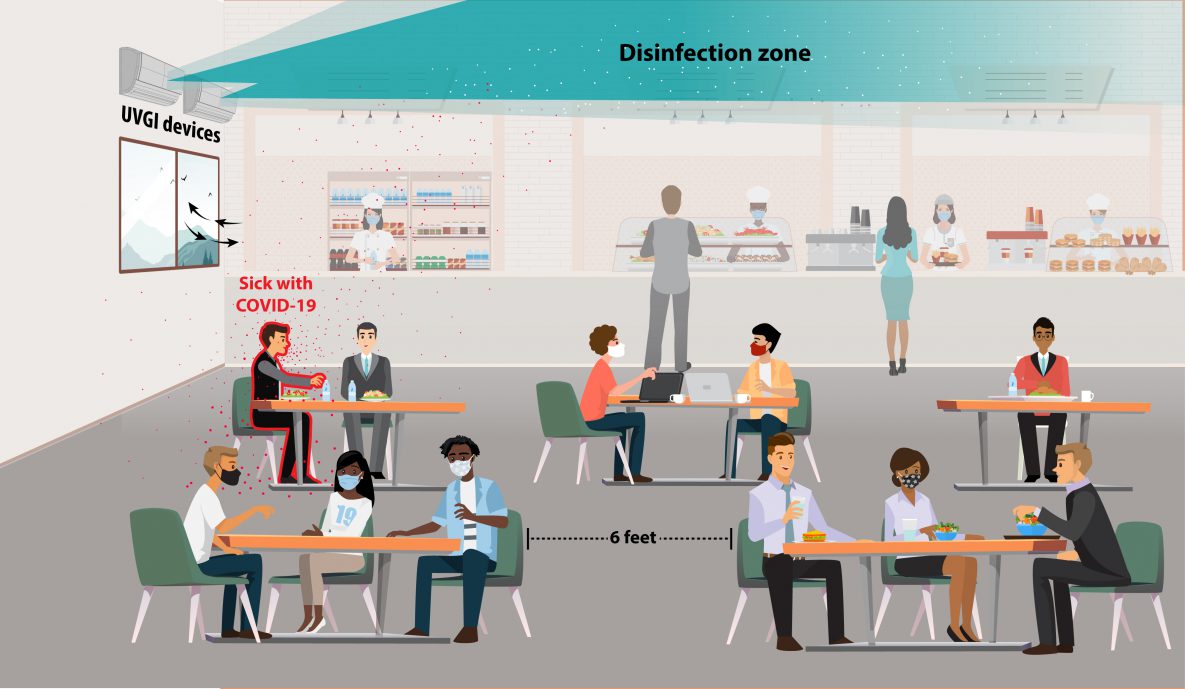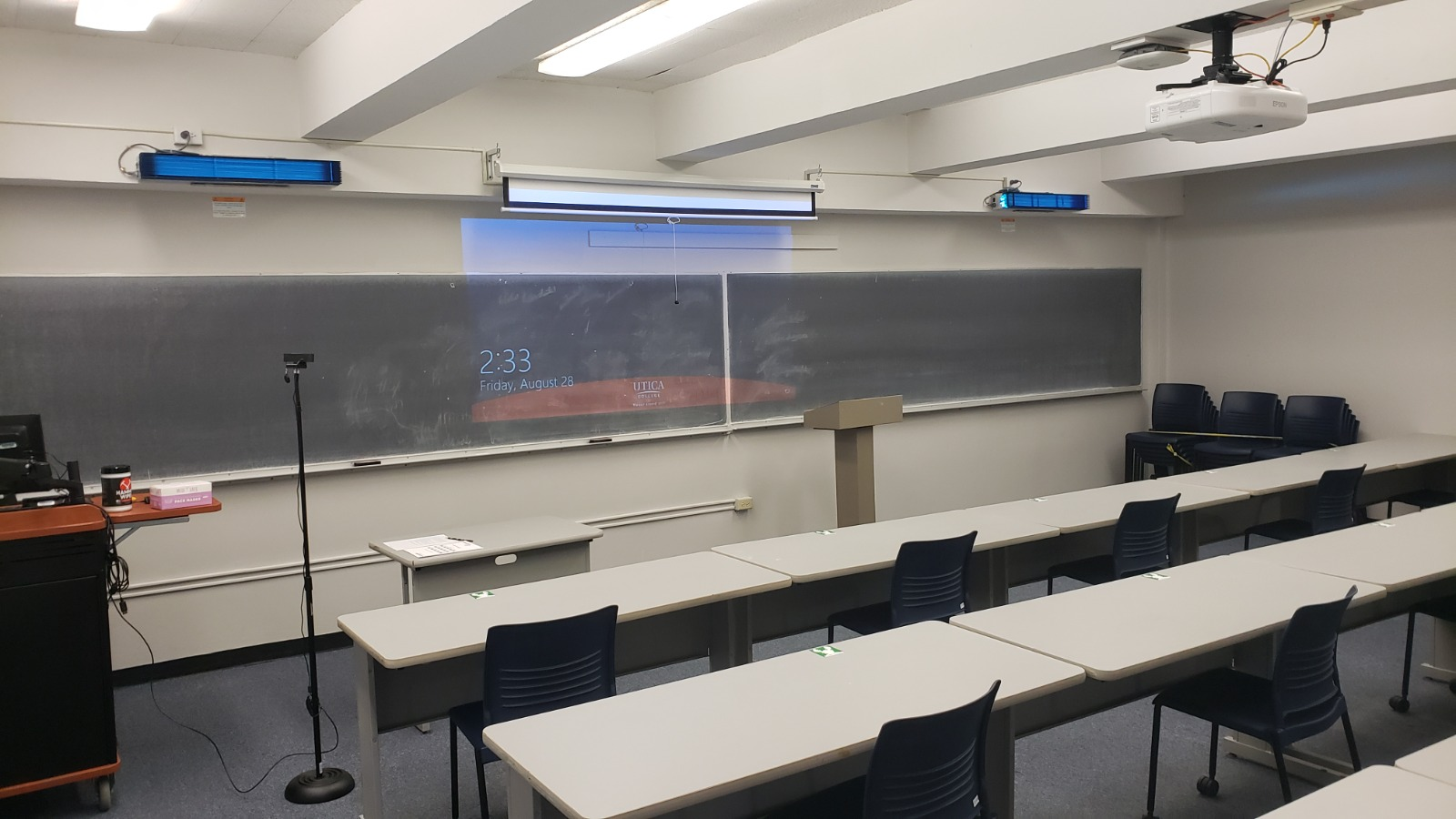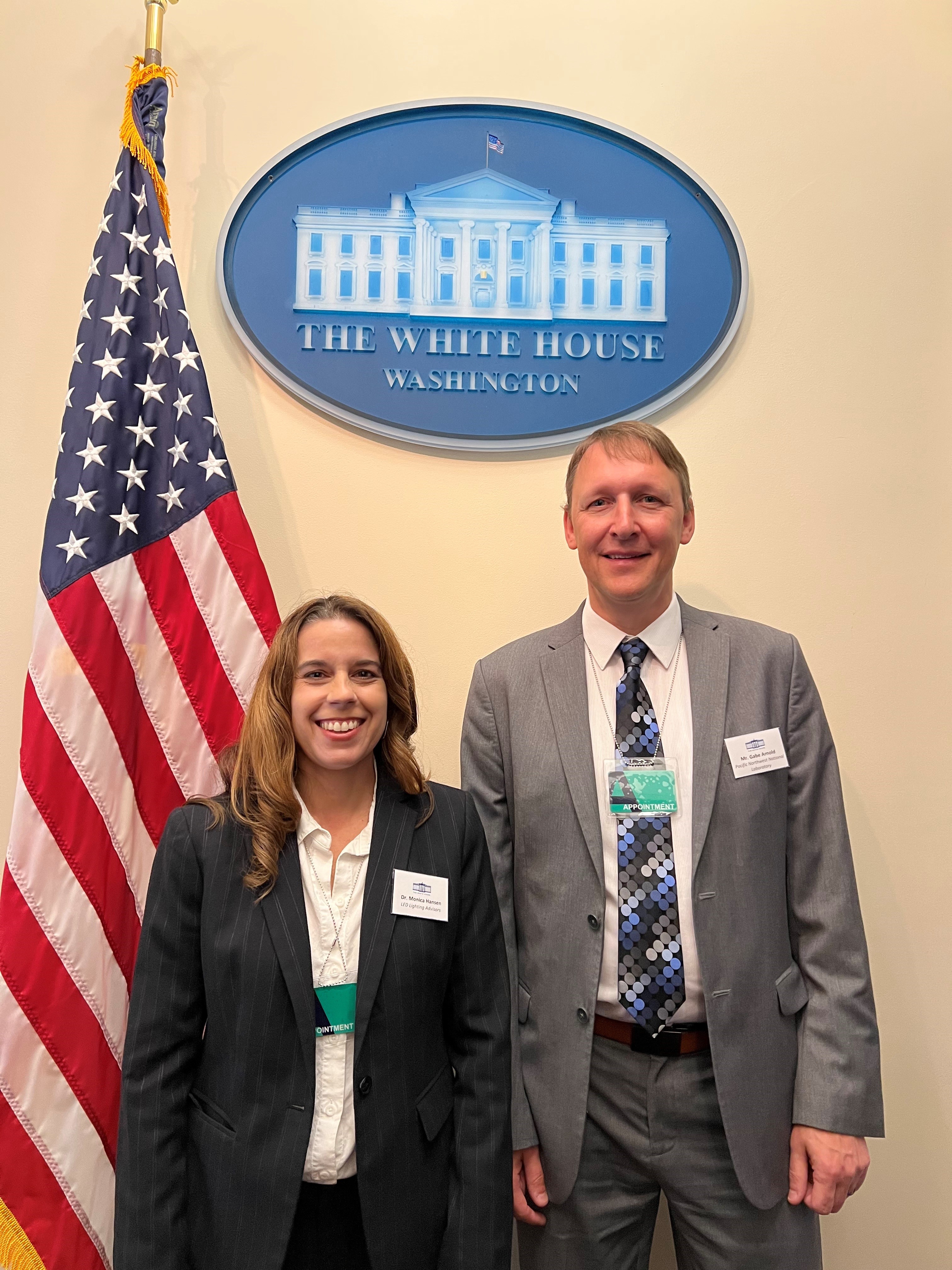PNNL Researchers Advance Germicidal Ultraviolet Technologies
Can GUV improve indoor air quality without sacrificing energy efficiency?

Students at Cambridge Friends School in Cambridge, Massachusetts raise their hand to participate. Directly below the ceiling is a GUV fixture that disinfects and kills viruses, bacteria, and fungi.
(Photograph courtesy of David Tierney | Cambridge Friends School)
The COVID-19 pandemic underscored the importance of indoor air quality for health and its role in mitigating or contributing to the spread of infectious diseases. In response, organizations such as the Center for Disease Control (CDC) and ASHRAE recommended increasing ventilation and improving HVAC filtration in commercial buildings.
Unfortunately, these measures can come at a significant cost to energy efficiency and greenhouse gas emissions in commercial buildings.
Enter germicidal ultraviolet (GUV) disinfection technology.
Pacific Northwest National Laboratory (PNNL) researchers Gabe Arnold, Belal Abboushi, Jason Tuenge, and Tim Salsbury think GUV holds the promise of contributing to healthier buildings and cleaner air for building occupants with better energy efficiency and lower carbon emissions than alternative approaches.
Earlier this year they conducted a literature review and found ample evidence suggesting that GUV is more effective at reducing virus concentration or infection risk than increased ventilation measures recommended by CDC and ASHRAE. Their findings were published in a paper presented at the American Council for an Energy-Efficient Economy's (ACEEE) 2022 Summer Study on Energy Efficiency in Buildings conference.
GUV uses ultraviolet (UV) radiation—like the UV present in sunlight—to disinfect and kill viruses, bacteria, and fungi. Most GUV fixtures used for disinfection produce UV-C energy, which has shorter wavelengths than UV-A and UV-B rays and poses less risk to human health. The PNNL team’s paper specifically looks at upper-room GUV applications, which refers to the installation of GUV fixtures that direct UV rays above occupants to prevent exposure to UV radiation.

In addition to providing better disinfection, the studies reviewed by PNNL also indicate that GUV may use substantially less energy than increasing outdoor air ventilation or air change rates.
“The potential stakes for cutting down on energy use and carbon emissions are large,” said Arnold.
For example, a recent study estimated that increasing minimum outdoor air ventilation to 100 percent across the U.S. commercial building stock as a COVID-19 mitigation measure would increase overall national commercial building energy use by 24.5 percent and natural gas use by 75.2 percent, directly contributing to increased carbon emissions since gas-fired heating is used in a big percentage of ventilation systems. GUV also presents an electrification opportunity as an entirely electric mitigation measure.
Quantifying the benefits
“The paper we published clearly indicates the higher effectiveness and decarbonization opportunity is there, but there is more work needed to characterize exactly how much more effective GUV technology is in different applications and how much energy it saves in the long run,” said Arnold.
So now they’re building a sophisticated model as part of a new project sponsored by the Department of Energy’s Building Technologies Office. The model created by Salsbury and modeling researcher Cary Faulkner will be used to compare the effectiveness and energy use of different combinations of mitigation measures to reduce disease transmission.
Their goal is to characterize and quantify the energy efficiency, decarbonization, and electrification benefits of GUV technology across different building types and climate zones. This information can inform recommendations, guidelines, codes, and standards, helping building owners and operators determine the most effective and energy-efficient combinations of measures to curb the spread of disease in their facilities.
Putting GUV to the test

As part of the project, the team is also putting GUV technology to the test through product testing and field evaluations. GUV technology is not new, it's been used extensively in healthcare settings for decades. But the COVID-19 pandemic brought a renewed interest in GUV across all sectors and with it some concerns about the safety and the validity of claims marketed by commercially available products, many of which have not been properly studied, tested, or validated.
“As a designer, specifier, or buyer, how do you know one product is better than the other and as a manufacturer how do you know which tests you need to perform and how you accurately report results,” said Arnold, “these are critical insights needed to support the wider deployment of GUV.”
The team is reviving a product testing program called CALiPER to test commercially available GUV products. Beyond assessments of radiometric performance and germicidal efficacy, the team will also assess issues like photobiological safety, material degradation, and operation and maintenance impacts.
“We're taking a practical engineering approach to evaluate common issues with products and applications to help ensure the technology is deployed safely and effectively for the benefit of building occupants and our decarbonized energy future," said Kelly Gordon, manager of the Advanced Lighting Program at PNNL.
Helping the White House improve indoor air quality
PNNL’s GUV research aligns with the Biden-Harris administration’s goal to improve indoor air quality.

In October, the White House hosted a Summit on Improving Indoor Air Quality which convened public health and ventilation experts, private sector and education leaders, and others who have a role to play in improving indoor air quality. Arnold was invited to attend the summit for his role in leading PNNL’s research with GUV technologies.
PNNL also participates in a working group focused on germicidal ultraviolet systems organized by the White House Office of Science and Technology Policy. The group meets biweekly to coordinate research, development, and deployment needs to support a whole government strategy to address indoor air quality in the nation’s buildings.
“There is a lot of room to improve indoor air quality in this country in support of good health outcomes,” said Arnold, “but this is especially true in disadvantaged communities and buildings within them, where there are substandard ventilation systems to remove airborne pathogens. GUV is an important part of the solution to cost-effectively and energy-efficiently address these inequities and improve public health outcomes for all.”
Arnold appeared on the Get a Grip on Lighting podcast in September discussing GUV lighting’s role in improving indoor air quality and some of the work already underway.
Recruitment is underway to identify potential partner sites for GUV field evaluations. To learn more and submit your interest, visit the GUV Field Evaluation website. Deadline to submit is February 15, 2023.
Published: January 10, 2023